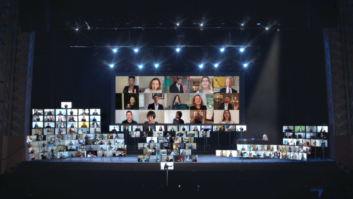SURROUND AUDIO MIGHT REQUIRE SOME DETECTIVE WORK – AND HAVING A GOOD LAWYER’S NOT A BAD IDEA, EITHER
As the major labels gear up to feed the consumer pipeline with DVD-A product, most will discover that there are often major hidden pitfalls when it comes to reformatting archival material. After sitting in a vault for two decades, many so-called master tapes are in poor physical condition, and if the tapes have been improperly stored or cataloged, then anything from a guitar solo to an entire reel of tape can go missing.
MANAGING THE MUSIC
“The problem in the music business is that 25 years ago, no one had any concept about the future uses of the recordings,” observes Blaine Graboyes, founder and creative director of Zuma Digital. The multimedia authoring and audio facility in New York City has been doing 5.1 remixes for a range of media, including film, television, advertising and music videos. “Now you pull a tape out – if you can find it – and you find five takes of the same song. They all sound the same to you; only one is the approved version, and the engineer’s been dead for 20 years,” Graboyes explains.
Graboyes applies terms picked up from Zuma’s corporate clients to describe the problems that the music industry faces as DVD-Audio attempts the transition from a novelty to a mass-market product. “The biggest issue in doing any kind of repurposing of previously used creative elements is `knowledge management’ – the ability to know where all the assets of a project are and how to retrieve them,” he says. “And the absolute biggest problem that surround music faces on a day-to-day basis is missing assets, from pieces of recordings to the media itself. The second biggest problem is missing records of the asset. That is, the documentation that tells you things like how to use the asset, which pieces the artists intended to be used and which were not, and where to find the right pieces on the media. Without either of those things, you’re not going to be completely successful in repurposing them for new media.”
The stories of tapes moldering away forgotten in broom closets, dumped in the trash or auctioned off for a few dollars when studios and record labels close down are legion in the entertainment business. Proper archiving and record-keeping of the music media has been almost nonexistent. And that’s compounded, Graboyes adds, by the fact that the entertainment industry, in general, is a transient one. “The turnover rate in the music and film businesses is incredibly high,” he says. “One of our clients has had four different assistants, all of whom get up to speed on where things are and then leave, and the next person has to start all over again.”
It’s not just the golden oldies that are missing the most in music. Even relatively recent recordings show up with missing pieces, slowing down or completely halting the remixing process. Jake Nicely, co-owner of Seventeen Grand Recording in Nashville and one of the leading multichannel remixers in the music industry, was contracted this year to do a DVD-Video multichannel remix of a live album by the country group Alabama. Though the record was originally released in stereo in 1998 on RCA Records, pieces of the master recording quickly went missing, and Nicely had to turn to gumshoe detective techniques to get the project moving.
“When they recorded the concert, they didn’t have enough tracks on the 48-track tape for the audience tracks and the MC’s announcements, so they slaved those off onto a DA-88 tape,” Nicely recounts. “But when it came time to do the [multichannel] remix, no one could find the DA-88 tape. This is a live record, so the audience tracks are incredibly important to making it work, especially in surround. We started calling around, trying to track the tape down, and everyone kept saying, `Yeah we had it, but we turned it over to so-and-so,’ and so-and-so told us they turned it over to someone else, and so on and so on down the line.
“Finally, I found out the tape had been over at TNN [country cable channel The Nashville Network] from when Gaylord [Entertainment] used it in post-production for a broadcast,” continues Nicely. “So I drove over there and asked their tape log person for it, and she had no record of it. It had never been logged into their vault, so she said it couldn’t be there. But I asked her if I could look around in the vault anyway, and in there I happened to glance at a pile of tapes in a little bin marked `To Be Erased,’ and there it was. The tape girl said she was supposed to erase the tapes for reuse but just hadn’t gotten around to it. Had I gotten there a day later…”
Chuck Ainlay has also run into the kinds of problems that result when documentation is missing. Ainlay has recently been working on a 25th anniversary 5.1 re-release of Peter Frampton’s huge ’70s hit Frampton Comes Alive and describes the kind of problems that crop up even after all the media assets are collected. “It was a live recording, but there were parts that were fixed with overdubbing in the studio afterward,” Ainlay explains. “We had very little documentation on the tapes, and we had to rely on Peter’s fantastic memory when it came to which parts were the ones used on the final version. In doing surround remixes, you want to stay true to the original vision of the recording, so every little piece counts.”
Most of the Frampton record’s tracks were taken from shows at San Francisco’s Winterland venue, but audience effects from other concerts were also added to the original album. “If you listen closely [to the original], you can hear where you go from one crowd sound to another in different songs,” notes Ainlay. “There’s three different crowds on the record; they didn’t have the digital editing and the ability to do crossfades like we have now. So to get the same crowd noises in the same places, you listen for cues, like a guitar note or a firecracker, and then you sample it and put it in.”
Many of the issues raised in surround music have been seen before in surround for film and are now showing up in the production process while creating surround audio for DVD-Video. Cynthia Banach, VP of operations and a mixer at Zuma Digital, notes that she increasingly encounters poorly stored tape elements and M&E tracks with missing sound effects. In the latter case, she has more than once had to go out and redo a film’s Foley effects, using the original video release as a guide track. This slows down the work considerably, with additional levels of approvals required when new sound elements are added to a project.
THE LEGAL ANGLE
Banach has had her work slowed down at times, and sometimes stopped altogether, when music tracks for films arrive with songs completely different from those on the original release. It often happens that the company that now has the rights to the film may not have been able to get approvals renewed for the DVD soundtrack. “People acquire the rights to distribute films, sometimes from estates or from other means, but that doesn’t necessarily mean that all the elements are automatically also licensed,” says Banach.
And the need to fill up to four more channels of information is already leading to the addition of elements that were not part of the original artistic entity. In one instance, Jake Nicely was working on a DVD music video of a George Strait concert. “The acoustic/electric guitar player had been having technical problems onstage, so the instrument wasn’t recorded on a couple of songs,” Nicely explains. “It was something that was important to the song and the mix, so I picked up a guitar and played the part myself and recorded it and put it into the mix. We could have called the original guitar player, but he was out on the road and that would have slowed the whole project down, plus added an additional cost to the mix. So I just figured to do it myself.”
That seemed like an obvious solution, and in this instance carried little liability, either artistic or legal, because the part being replaced was not done by any component of the artistic entity that would be compelling to consumers. In other words, people buy the DVD because they are interested in George Strait, not his hired band.
But the surround post-production process offers the potential for much more wide-ranging enhancements to music projects. What happens if musical parts played by a band member are irretrievable for a surround remix or can’t be resampled? Does the project stop? Is the band member contacted to play the part again? Suppose that person refuses or asks for too much money? Can the rights holder of the sound recording – which is very often not the artist – pay for a less-expensive replacement part to be played and recorded? If that is the case, must the rights holder advertise that the re-released surround version of the recording does not contain solely original elements? A similar scenario has played out hundreds of times in recent years as oldies and classic rock bands headed out on tours years after their last hits, often with few or in some cases, none, of the band’s original members onstage. Often, none of the original band members have any legal rights to the names of their own bands. Court cases have been filed in the past seeking to put the musical equivalent of truth-in-labeling into such shows.
What are the legal implications when elements are irretrievably lost? Ken Kraus, a music business attorney at Loeb & Loeb in Nashville and who was involved in the negotiations to bring Steely Dan records into the DVD domain, says the answers are unclear at this point, but that DVD-Audio appears to be a new minefield in the music business. “A sideman added to a record or deleted from one is fairly simple – the employer owns his services,” Kraus says. “But in the case of a band member, it’s more difficult. What’s the artist’s claim to the artistic entity, and what documentation does the artist have? Also, it becomes important as to how a record is represented to the buying public, as either containing all the original elements from the first version or with new elements that might change the recording. All of that has to be clear before a label should authorize a remix.
“Then there’s the issues regarding the record labels’ responsibilities for the safekeeping of the masters,” Kraus continues. “What if the label loses the tape? That happened for a period with Steely Dan. There’s an awful lot of tape out there, and no one knows where it is. What losses can the artist allege if they’re not able to re-release a recording and make more money from it, because the label can’t find the tapes?”
Could studios be held liable for being party to artistic liberties in the pursuit of surround mixes? There is nothing specific in the legal literature yet on the matter, but precedent seems to indicate that they could. Over the last three years, the Recording Industry Association of America (RIAA) has sued several large CD replicators on the grounds that they were manufacturing discs containing material that was not properly licensed. And the suits have been successful – RIAA has won over $25 million in judgments against some replicators, including a record $10 million from Americ Disc alone.
It’s unlikely that anyone will try to fill in missing guitar parts of a Jimi Hendrix record with a ringer. But what happens when someone hires Jimmy Vivino to re-create the rhythm guitar part of a Foghat record from 1976 because the tape was damaged? “It’s a matter of how significant the part is, and how it’s represented,” says Kraus.
As Zuma Digital’s Graboyes points out, regardless of who owns the rights to musical material, there needs to be some acknowledgment of the implicit right of the original artist to maintain the integrity of the original artistic vision. “On the other hand, though, we also have to realize that musicians are at the extreme end of the artistic temperament,” he says, “and we have to find ways to balance those needs with the need to get work done. All the while, we have to keep in mind that the financial records are part of the documentation of the assets, too. There’s a lot to watch out for.”





